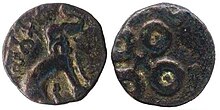Satakarni
| Satakarni | |
|---|---|

Early coin of Satakarni, Maharashtra - Vidarbha type
|
|
| Satavahana King | |
| Reign | 1st century BCE |
| Predecessor | Kanha |
| Successor | Vedasri Satisiri |
| Spouse | Nayanika (Naganika) |
| Issue | Vedistri Satisisri |
| Dynasty | Satavahana |
| Father | Simuka |
| Satavahana Kings (271 BCE – 220 CE) | |
| Simuka | (1st century BCE) |
| Kanha | (1st century BCE/CE) |
| Satakarni | (1st-2nd century CE) |
| Sivasvati | (1st century CE) |
| Gautamiputra Satakarni | (1st-2nd century CE) |
| Vasishthiputra Pulumavi | (2nd century CE) |
| Vashishtiputra Satakarni | (2nd century CE) |
| Shivaskanda Satakarni | (2nd century CE) |
| Yajna Sri Satakarni | (2nd century CE) |
| Vijaya | (2nd century CE) |
Satakarni (Sātakarnī I) was the third of the Satavahana kings, who ruled the Deccan region of India. His reign dated variously as 70-60 BCE, or 187-177 BCE.
According to the Puranas, the Satavahana king Simuka was succeeded by his brother Krishna (also known as Kanha). According to Matsya Purana, Krishna was succeeded by Mallakarni, but according to other Puranas, he was succeeded by Satakarni. The Nanaghat cave inscription of Satakarni lists his family members: it mentions Simuka's name, but not that of Krishna. Based on this, multiple historians conclude that Satakarni was Simuka's son, and succeeded Krishna. G. V. Rao, however, believes that the inscription is that of a different king Satakarni II; Simuka is mentioned in the inscription as the founder of the dynasty.
According to the Matsya Purana, Satakarni enjoyed a long reign of about 56 years. He seems to have conquered Western Malwa region from the Shungas.
He married Nayanika (Naganika), daughter of the Maharathi Tranakayiro Kalalaya, scion of the Amgiya (Ambhiya) family. She wrote the Naneghat inscription, in which she describes Satakarni as "Lord of Dakshinapatha, wielder of the unchecked wheel of Sovereignty". The Naneghat inscription of Naganika suggests that Satakarni performed two horse sacrifices (Aswamedha), to proclaim his sovereignty.
The Hathigumpha inscription of the Kalinga king Kharavela mentions a king named "Satakani" or "Satakamini", who is identified with Satakarni. The inscription describes dispatching of an army and Kharavela's threat to a city variously interpreted as "Masika" (Masikanagara), "Musika" (Musikanagara) or "Asika" (Asikanagara). NK Sahu identifies Asika as the capital of Assaka janapada. According to Ajay Mitra Shastri, Asika-nagara was located in the present-day Adam village in the Nagpur district, where a seal mentioning the Assaka has been found. The inscription also mentions a river, variously identified with Krishna or with the combined flow of Kanha-Wainganga.
...
Wikipedia
